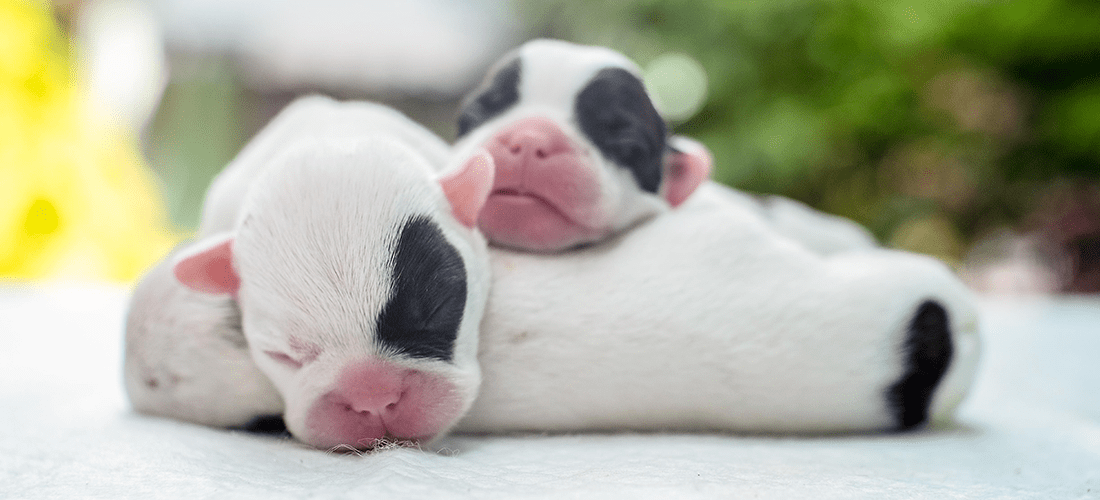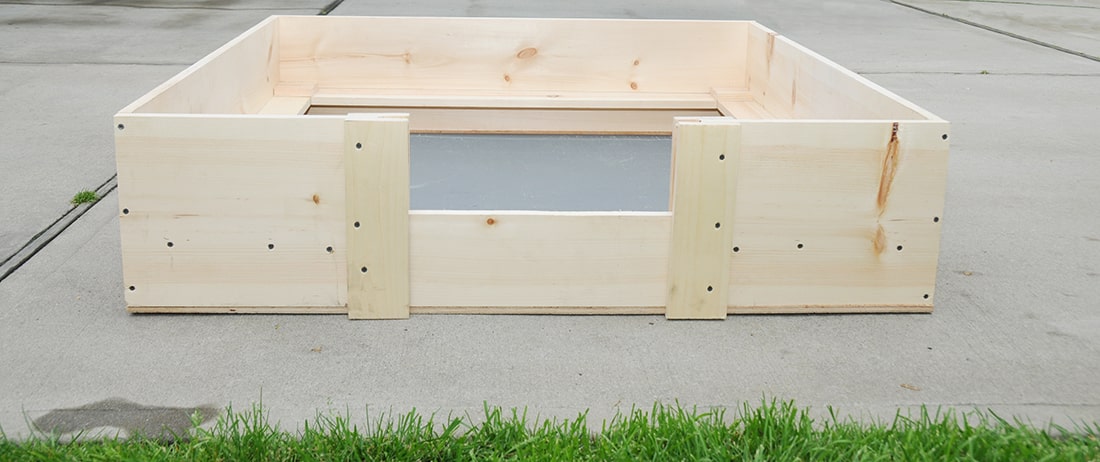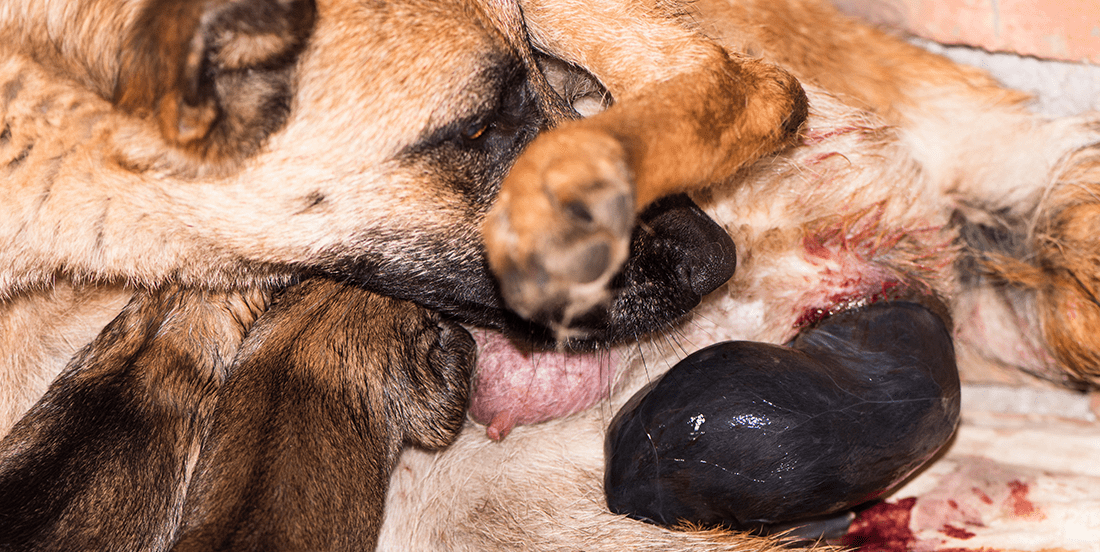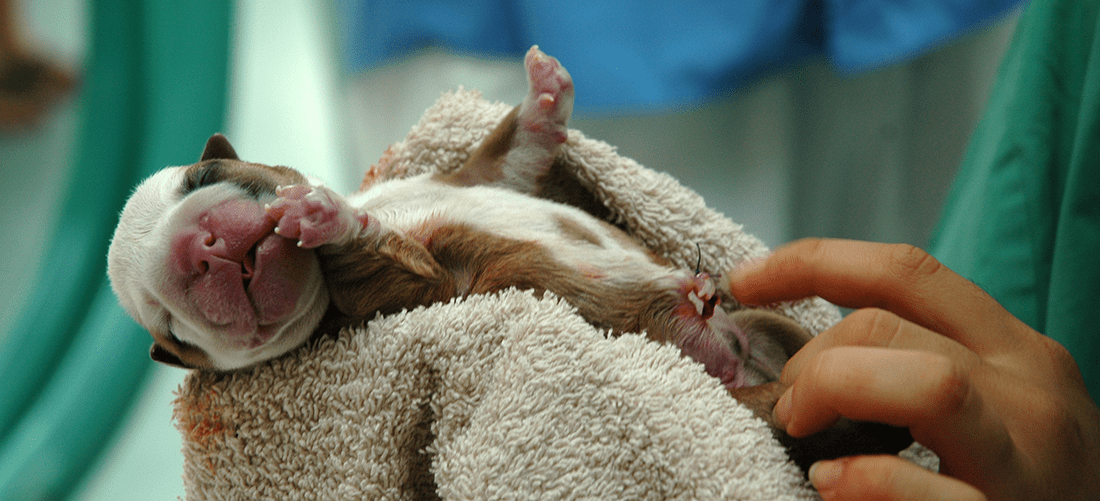Whelping – a guide to your dog giving birth
Overview
- If your dog is pregnant, it’s important to be prepared for her whelping (when she gives birth) to reduce the chance of any problems.
- Call your vet for advice immediately if your dog is having trouble giving birth or has been straining for 20-30 minutes without producing a puppy – a delay could be the difference between life and death.
- PDSA vets recommend neutering to reduce the risk of unwanted pregnancies.

This article is designed to help if your dog is whelping – you may also find the following information helpful:
- Pregnancy in dogs
- New-born puppy care (coming soon)
- Hand rearing puppies

You’ll need to start preparing for your dog’s whelping well before she goes into labour, and make sure you consider the following:
Due date
It’s important that you know roughly when your dog is due to give birth so you can fully prepare and monitor her even more closely around her due date. Dogs are usually pregnant for around 63 days (but this can range from 57-71 days).
Vet care
If you haven’t already, register your dog with a vet as soon as you suspect she might be pregnant. They will be able to guide you through her pregnancy and provide any necessary advice during her whelping. Have your vet’s daytime and out-of-hours telephone numbers saved in your telephone in case of any emergencies.
Whelping box
Once you know that your dog is pregnant, it’s a good idea to get everything ready, including a whelping box (see image above). You can either buy a pre-made box, or make one yourself (a large rigid cardboard box will often do). The box needs to be:
- Warm and comfortable.
- In a quiet, secluded room that’s kept at around 22°C.
- Lined with a clean, washable, absorbent bedding (towels are perfect).
- Big enough for your dog to stretch out and turn around in.
- High enough to stop newborn puppies escaping, but low enough for your dog to step over.
- Fitted with railings/barriers on the inside to stop any puppies being squashed against the walls.
Feeding, fleas, worms, and general care
Your dog will need slightly differently care during her pregnancy, including a change of food and more regular parasite treatments. For more information read our article on Pregnancy in Dogs.

Stage 1: Preparing for birth
As your dog prepares to give birth, her birth canal will relax and widen while her puppies turn around into the correct position. The preparation stage of whelping usually lasts between 6-12 hours, but can be as long as 36 hours (especially for a first time mum, or a nervous dog). During this stage, you may notice your dog:
- Becoming restless
- Hiding away
- Panting
- Eating less
- (contact your vet if you are concerned or she vomits a lot)
- ‘Nesting’ – digging, pacing and circling around her whelping box
- Passing a small amount of red/brown mucus from her vulva and having very weak contractions (but not straining)
Just before your dog starts having her puppies, she should start to settle down, ideally in her whelping box.
Stage 2: Giving birth
Once your dog is ready to have her puppies, she will begin having strong contractions and feel the need to strain.
- The first puppy often takes the longest to be born; if contractions are weak it might take between two-four hours, but if contractions are strong, they should come within 20-30 minutes.
- There will be a time gap between each puppy, which can range from five minutes to 1.5 hours. As long as your dog is comfortable and not straining, this gap between puppies is normal.
- If at any point your dog has been straining and having strong contractions for 20-30 minutes without progressing or producing a puppy, contact you vet immediately.
- Most puppies are born head first but some come tail first.
- Puppies are born inside a thin sac, which the mother will remove, enabling them to breathe.
- After each puppy, your dog should pass an afterbirth (placenta), which they often eat. The placenta is the structure that provides oxygen and nutrients to the puppy while it’s developing in the womb. A placenta should appear approximately 15 minutes after each puppy, however, they don’t always come in order (i.e. a few pups may be born before their placentas are passed). If not all placentas are passed, it’s possible for an infection called ‘metritis’ to develop in the weeks following whelping. If your dog has a large litter, it’s a good idea to stop her from eating too many placentas as this can lead to vomiting and diarrhoea.
- Between each puppy, your dog should be comfortable, settled and licking her newborn pups until her contractions restart.
- There will be some clear or bloody fluid coming from your dog’s vulva during whelping, this is normal. However, a lot of blood isn’t normal.
- You may see a small amount of green tinged discharge following a pup being born, but a thick green discharge without a puppy can indicate problems.
- Your dog won’t normally need help during her labour, and although it’s important to monitor her, it’s best not to examine her or attempt to help her give birth – interfering too much can cause problems after birth. If you’re worried your dog is having problems while whelping, it’s best to contact your vet.
Stage 3: After labour
- On average, giving birth to an entire litter takes 3-12 hours from the start of contractions/straining. Exact timing varies, but most dogs give birth to their whole litter with 6 hours.
- The process should never take longer than 24 hours – any longer and the risk of a problem becomes very high.
- Once your dog has given birth to all her puppies, she is likely to be very hungry and tired. She will need to eat, rest with her pups, bond with them and feed them – make sure they are in a quiet, comfortable space where they won’t be disturbed.
- If your dog isn’t comfortable and relaxed after whelping, there is a risk that she may reject her puppies and refuse to feed them.
Problems during whelping
Most dogs will give birth without help, but sometimes problems arise, which vets call ‘dystocia’ (difficulty giving birth). Dystocia is especially common in flat-faced breeds such as Pugs, Bulldogs and French Bulldogs. Contact your vet for advice if you notice any of the following problems:
General illness
If your dog seems unwell, has any symptoms of illness or is just ‘not herself’ at any point before, during or after whelping.
Straining but no pup
Contact your vet urgently if your dog has been straining for 20-30 minutes without producing a puppy – there may be a problem.
Green discharge
If you see a green discharge coming from your dog’s vulva without a puppy it could mean that an unborn pup is in distress (for example, if their blood and oxygen supply is failing).
Bleeding
You will often see some fluid and bloody discharge during a whelping, but anything more than a few drops of blood is abnormal and should be checked by your vet immediately.
Exhaustion
If your dog’s labour continues for a long time, or she is an older dog with less energy to start with, she may become exhausted, stop straining and need some help from your vet.
Puppy stuck
Large puppies, deformed puppies, and puppies delivered backwards can sometimes become stuck inside the pelvis or part way out. If your dog has puppy stuck inside her, call your vet immediately. Do not touch or try to pull out the puppy without specific advice and guidance from your vet.
Sac problems
Some dogs need help removing the birth sac from their puppies (especially first time mothers). Give your dog a chance to remove it herself, but if she hasn’t removed it fairly quickly after a puppy is born you may need to help her. Simply tear a hole in the sac and free the puppy’s head so they can breathe. Avoid using scissors, just tear a hole using your fingers – call your vet immediately if you’re struggling.
Umbilical cord problems
Most dogs nibble through their puppy’s umbilical cords (which attach the puppy to their placenta) as soon they are born. It’s not essential that they are removed straight away, but left too long, they can become infected or cause problems. If any of your puppies still have their umbilical cords attached a few hours after they are born, you may need to tie and cut them off yourself. You may also need to tie off any cords that are bleeding (often caused by the mother overenthusiastically nibbling them). Always call your vet for advice about how to properly tie and cut an umbilical cord – doing it incorrectly could cause an infection or hurt the puppy.
No puppies
If your dog has been confirmed pregnant, and hasn’t shown any signs of labour a few days after she is due (usually around 70-72 days after she was mated), contact your vet for advice.
Stillborn puppies
Always have your dog checked over if she gives birth to any dead puppies.
Fading or unwell puppies
Contact your vet immediately if any of your dog’s puppies aren’t breathing/moving, stop breathing, aren’t able to move/feed or have signs of illness.

If your dog is having trouble giving birth, contact your vet straight away and try to give as much detail about her and the pregnancy as possible. Your dog may need the following:
- Monitoring: your vet may decide to keep your dog in the hospital to monitor her and see what happens. Your vet will check her regularly and take further action if necessary.
- X-rays or a scan: x-rays and scans can help check the unborn puppies and diagnose any problems.
- Medication: if your dog is struggling to give birth, your vet may decide to give a medication called Oxytocin, which causes the womb to contract more forcefully. However, it’s important that your vet examines your dog before this is given because Oxytocin is not always appropriate, and used in the wrong situation can cause severe pain and tearing of the womb.
- Assisted delivery: if your dog is struggling to pass a puppy, it might be possible for your vet to gently help deliver it. However, if the puppy is too big or deformed to pass through the pelvis, your dog may need a caesarean section. Never pull a puppy without advice from your vet; you could seriously injure your dog and/or the puppy.
- Caesarean: A caesarean section is an operation performed under a general anaesthetic to open the womb and remove the puppies.
Problems after pregnancy
There are a few things you will need to keep a look out for after your dog has given birth:
Mammary problems
It’s a good idea to check your dog’s mammary glands daily to make sure she’s producing enough milk to feed her puppies, and isn’t developing any problems, for example mastitis (a painful infection of the mammary glands). Contact your vet for advice if you notice any of the following symptoms:
- Lack of milk
- Pain
- Redness
- Itching
- Swelling
- Abnormal coloured milk
Metritis (infection of the womb)
Metritis is an infection inside the womb. It’s an uncommon, but very serious problem that tends to mostly affect dogs that have had trouble giving birth, or have puppies/placentas left behind in the uterus (very rare in dogs). Metritis tends to cause symptoms such as low energy, reduced appetite, high temperature, a smelly vaginal discharge and reduced milk production. If you notice any of these symptoms contact your vet for advice immediately.
* It’s normal for your dog to have some vaginal discharge for up to 6 weeks after she whelps, but it should not smell and she shouldn’t develop any other symptoms of illness.
Eclampsia (hypocalcaemia)
Eclampsia (otherwise known as puerperal tetany and hypocalcaemia) is a life threatening condition caused by low calcium, which tends to develop in the last few weeks of pregnancy/first few weeks after giving birth. It is most common in small dogs with large litters, dogs that haven’t had the correct nutrition in their pregnancy and dogs producing a lot of milk. Dogs that have been supplemented with calcium throughout pregnancy are also at a higher risk of eclampsia, which may seem surprising, but calcium supplements actually make eclampsia more likely because the body becomes reliant on them and unable to use its own calcium when necessary. Symptoms of eclampsia include drooling, stiffness, becoming weak and wobbly, acting differently, muscle twitching, spasms and eventually seizures. If you notice any of these symptoms before, during or after your dog is giving birth, contact your vet immediately.
Behavioural/mothering problems
Most dogs take to motherhood very instinctively, but some find it a little more challenging, especially if they have had a caesarean, a stressful birth, or needed a lot of help from their owner/vet. To reduce the chance of a problem, set up a whelping box for your dog well before she’s due to give birth, and make sure it’s positioned in a warm, quiet, calm place way from the busy areas of your home. Keep an eye on your dog while she’s giving birth and only intervene if absolutely necessary. Call your vet for advice if you are worried about your dog at any point during her pregnancy or whelping.
- Should I let my dog have puppies?
- What should I do if my dog isn’t giving birth?
- How long is a dog pregnant for?
- What are the risks of whelping?
- How long does a dog bleed for after giving birth?
Should I let my dog have puppies?
Dogs don’t need a litter to live a normal, healthy life – and they certainly don’t need to have one litter before they are neutered. Sadly, there is an abundance of unwanted pups in rescue centres across the UK and many of these are the results of unwanted/unplanned pregnancies. Pregnancy also puts a big strain on your dog’s body and can lead to serious medical problems. For these reasons, PDSA recommends neutering your dog before her first season to avoid unwanted pregnancies, especially if you are worried about the stress involved with pregnancy, the birth, any complications, costs, or finding responsible, loving homes for the puppies.
What should I do if my dog isn’t giving birth?
Call your vet if your dog hasn’t started whelping as expected, or is having trouble giving birth. Make sure you have all the details of the mating if known.
How long is a dog pregnant for?
It can vary, but the average length is 63 days (9 weeks).
What are the risks of whelping?
Most dogs whelp without any trouble, but if problems arise, you should contact your vet straight away. Left untreated, problems during whelping can risk the unborn puppies, and mother’s life.
How long does a dog bleed for after giving birth?
There is usually a small amount of blood produced around the time of whelping, but anything more than a few drips is abnormal and should be checked immediately by your vet. It’s normal for your dog to have a vaginal discharge for up to 6 weeks after she whelps, but it should not smell.
Published: November 2021
Did you find this page useful?
Tell us more
Please note, our vets and nurses are unable to respond to questions via this form. If you are concerned about your pet’s health, please contact your vet directly.
Thank you for your feedback
Want to hear more about PDSA and get pet care tips from our vet experts?
Sign up to our e-newsletter
Written by vets and vet nurses. This advice is for UK pets only. Illustrations by Samantha Elmhurst.

